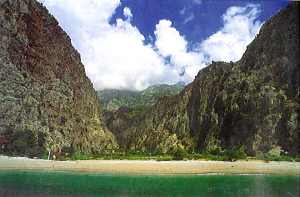|
|
|
|
|
 Butterfly
Valley opens onto a cove near Fethiye on Turkey's southwest coast. This deep steep-sided
valley has a floor of approximately ten hectares in area where almost all the butterfly
and moth species of the Mediterranean coastal region are to be found, making it an
open-air natural history museum. The abundance of lepidoptera is owing to the
humid microclimate created by waterfalls in the valley, and also to the hundred or so
different plant species found here. The butterfly which inspired the valley's name is the
so-called leopard butterfly (Euplagia quadripunctaria), one of the loveliest
members of the Arctiidae family. Between June and October hundreds of these
butterflies gather in a large colony here. Butterfly
Valley opens onto a cove near Fethiye on Turkey's southwest coast. This deep steep-sided
valley has a floor of approximately ten hectares in area where almost all the butterfly
and moth species of the Mediterranean coastal region are to be found, making it an
open-air natural history museum. The abundance of lepidoptera is owing to the
humid microclimate created by waterfalls in the valley, and also to the hundred or so
different plant species found here. The butterfly which inspired the valley's name is the
so-called leopard butterfly (Euplagia quadripunctaria), one of the loveliest
members of the Arctiidae family. Between June and October hundreds of these
butterflies gather in a large colony here.
Most people make day trips to the valley by boat from the Ölüdeniz lagoon, a trip of 30 minutes. The boats usually stop off on the way at the Blue Cave, and if the captain of your boat stays here long enough for a swim, do not miss the chance to swim into the cave and experience the full impact of its beauty. The valley lies in the foothills of the 2000 metre high Mount Babadağ and runs between soaring rock walls. An alternative way to arrive is by hang-glider off Babadağ, so making a spectacular flying start to your visit.
Over recent years many people have come to Butterfly Valley not just as day trippers from the lagoon, but to stay and enjoy its scenery wildlife at leisure. They include naturalists doing research and young visitors and students who come here for alternative holidays. Building development is prohibited in the valley, but those who wish to stay overnight may use the shelters covered by branches and leaves, platforms built in the trees, or bring tents with them. In the evenings as a camp fire blazes on the beach, you can watch the stars.
Turkey is a country at the junction of three continents, and both its flora and fauna are exceptional in their diversity. Some of the most spectacular members of the world of butterflies and moths, Machaon and Podalirius of the Papilionidae family, are widely found in every region of Turkey. A rare butterfly, Alexanor, which is not found in Europe at all, is found in some areas of the country. Endemic species found in limited areas of the country are an important illustration of Turkey's biological diversity, such as Maniola telmessis found in Fethiye which is a subspecies of the more widespread Maniola jurtina. The name telmessis refers to the ancient name for Fethiye. Apollo butterflies are a Turkish species which lives at an altitude range of 2000-2500 metres and is larger than its European counterparts. Cabbage whites - Pieris rapae, the chrome yellow Colias, and red admiral Vanessa atalanta are widespread all over Turkey. Painted ladies are found across much of the world and migrate in large flocks. Another migrating species, Danaus chrysippus, is one of the Mediterranean regions loveliest butterflies. The tiny Yptima is common in southern Turkey but unknown in Europe, while Krinia roxelana and Archon apollinus are only seen in Turkey and Greece.
Unfortunately no fully comprehensive list of all the butterflies living in Turkey has ever been drawn up, and at high altitudes in southeast and eastern Turkey no systematic research has been carried out at all. Information about Turkish moth species is even more sparse. A massive three volume work entitled Die Tagfalter der Türkei published in London by Classey in 1996 is the most comprehensive study of the subject at present.
|